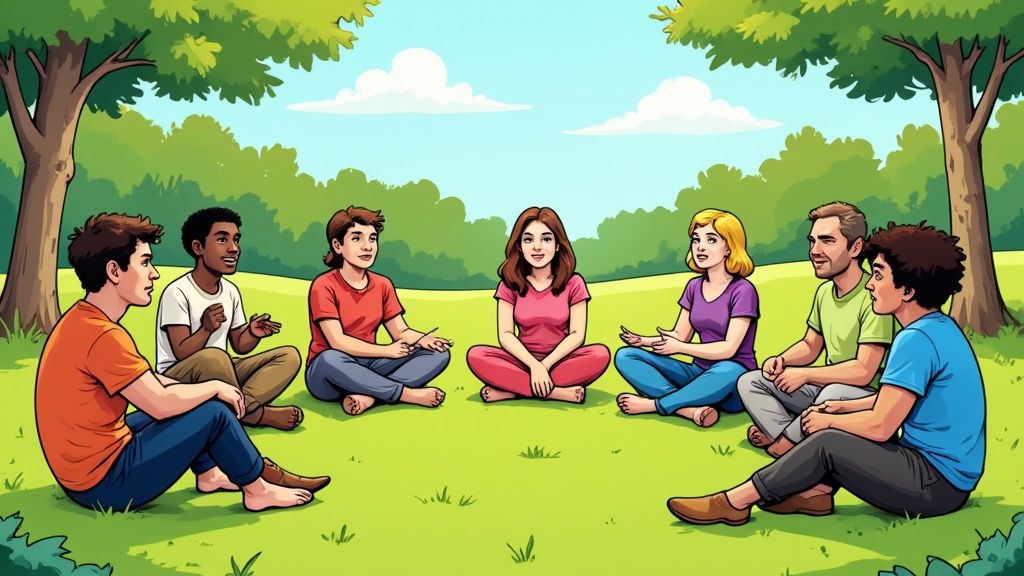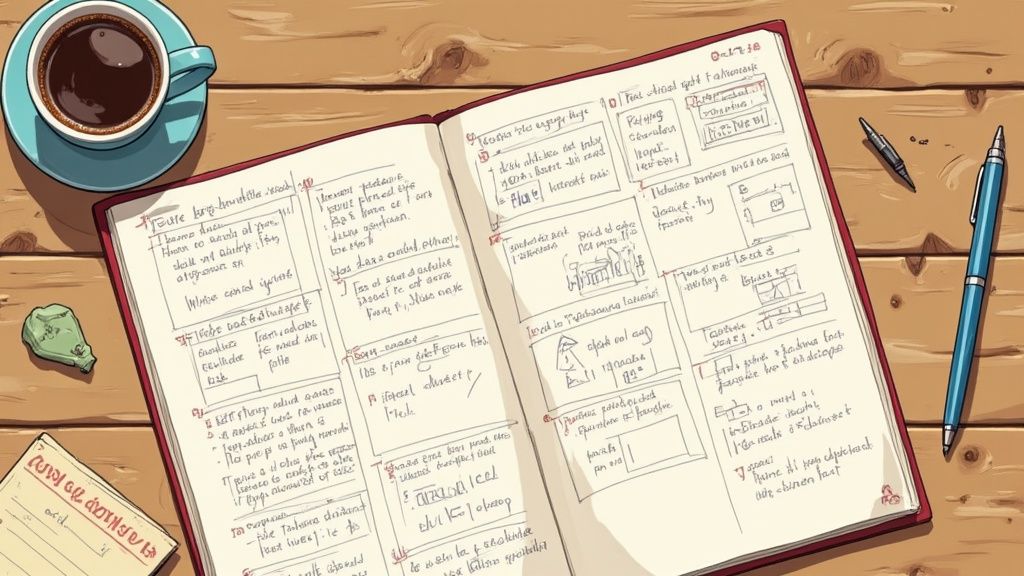10 Powerful Coaching Exercises for Groups: Transform Team Dynamics Today


Understanding the Power of Group Coaching
Group coaching brings togeher indivdual developmnt and team-based lerning in a special way. When peple learn and grow togeher, they achive more than they could alone. Membres benefit from expert coaching while also learning valuabl lessons from their piers.
The Science Behind Collective Growth
Sharing experiences with others facing similar challenges creates a strong sense of community. For example, entrepreneurs working to grow their businesses find both comfort and motivation in connecting with others on the same journey. Learning accelerates as group members share what works and what doesn't.
The group setting provides natural accountability and encouragement that helps drive positive change. This is especially valuable for developing leadership and team skills where collaboration matters most.
Research confirms the benefits - a 2022 study found that group coaching programs significantly boost self-awareness and engagement at work. The study of a "Becoming your own CHO (Chief Happiness Officer)" program showed improvements in reflective development and workplace proactivity. Learn more in this research paper.
Building Growth Through Group Dynamics
The interactions within group coaching sessions create ideal conditions for development. Members gain new perspectives from others' diverse experiences and backgrounds. This broadens thinking and opens up fresh approaches to problem-solving.
Practical Uses of Group Coaching
Group coaching works well in many settings:
Leadership development programs
Team building workshops
Communication skills training
Problem-solving sessions
Strategic planning
For example, communication-focused coaching exercises for groups might include role-playing or active listening practice. Leadership development could involve group discussions about decision-making strategies.
By understanding these core principles and designing targeted exercises, coaches can help groups achieve meaningful growth together. The collective learning environment amplifies individual development while building stronger teams.
Essential Team Building Exercises That Actually Work

Team building exercises go far beyond simple icebreakers. The most effective activities create meaningful connections and improve how teams work together. When done right, these exercises build trust and psychological safety - key ingredients for high-performing teams.
The Tree of Life: A Powerful Exercise for Self-Discovery and Team Cohesion
The Tree of Life exercise gives team members a creative way to share their stories and connect on a deeper level. Originally used in narrative therapy, this activity helps people explore their background, values, and aspirations in a supportive group setting.
What You'll Need: Paper, pens, colored pencils (optional)
How It Works: Each person draws a tree and labels:
Roots: Family history and cultural influences
Trunk: Core skills and values
Branches: Future hopes and goals
Leaves: Important relationships
Fruits: Gifts received from others
Flowers/Seeds: Legacy they want to leave
Participants share their trees in small groups or with the full team. This reveals shared experiences and values while building empathy and understanding.
Building Consistency Through Group Activities
Regular team activities help build reliable habits and shared accountability. For example, try creating a "Team Success Jar" where the group adds small rewards when hitting weekly targets. This positive approach reinforces commitment while making goal achievement fun and collaborative.
Communication Exercises: Enhancing Active Listening and Feedback
Strong communication skills are essential for any successful team. Try this proven listening exercise: pair up team members as speakers and listeners. The speaker describes a challenge while the listener practices reflecting back what they hear without trying to solve the problem. This builds active listening abilities and deeper understanding. Regular feedback sessions, guided by a facilitator, also help teams communicate openly and learn from each other.
Adapting Exercises for Different Group Dynamics
Teams come in all shapes and sizes - exercises should flex to fit each group's needs. For remote teams, use digital tools like online whiteboards to run activities virtually. Large groups can break into smaller discussion circles to ensure everyone participates meaningfully. The key is thoughtfully adapting activities while preserving their core benefits.
Leadership Development Through Group Dynamics
Learning to lead is enhanced in group settings. Working with peers allows aspiring leaders to gain hands-on experience, constructive feedback, and mutual support as they develop their abilities. Facilitators can design focused group activities that promote collaboration and accelerate skill development, helping participants learn from each other's diverse experiences and perspectives.
Cultivating Emotional Intelligence Through Group Exercises
Emotional intelligence (EQ) forms the foundation of effective leadership. Group coaching activities provide targeted opportunities to build EQ skills. For instance, role-playing challenging conversations helps leaders practice empathy and clear communication. Group discussions about recognizing and handling emotions also strengthen self-awareness and improve interactions with others.
Enhancing Decision-Making Capabilities in a Group Setting
Sound judgment and decision-making define great leadership. Group coaching scenarios let participants collaborate on making choices together. They can analyze real-world case studies, propose solutions, and weigh different perspectives. This hands-on practice helps leaders sharpen their analytical abilities while learning to consider multiple viewpoints before reaching conclusions.
Strengthening Strategic Thinking Through Collective Brainstorming
Long-term vision and strategic planning are essential leadership qualities. Group coaching leverages collective brainstorming and planning exercises to build these skills. Teams might develop a complete strategic plan for a sample organization, learning to set objectives, manage resources, and prepare for potential challenges. This collaborative approach sparks creative problem-solving.
Building Leadership Skills Through Shared Experience
Group coaching creates powerful opportunities for developing core leadership abilities like self-awareness, courage, and perspective-taking. A study of executive group coaching with ten department heads in a Swedish municipality highlighted these benefits. The research showed how group engagement, reflection time, and exposure to diverse viewpoints enhanced leadership growth. Learn more about this research here. Through structured group activities and shared learning, leaders gain essential skills while supporting each other's development.
Problem-Solving Exercises That Drive Real Results

Getting the most from a group's combined knowledge requires more than basic discussion. Success comes from well-designed exercises, expert facilitation, and clear goals focused on practical solutions. Let's explore proven approaches that help teams overcome challenges and achieve measurable progress.
Facilitating Productive Brainstorming Sessions
The key to effective coaching exercises for groups is starting with clear, specific objectives. Instead of broad goals like "improve teamwork," define concrete targets such as "reduce project handoff errors by 50%." Set ground rules that encourage creativity - no judging ideas early on, aim for quantity over immediate quality. This focused approach helps teams generate more useful solutions.
Building Consensus and Driving Action
Once ideas are flowing, the next step is selecting the best solutions as a group. Dot voting is a simple but powerful technique - each person gets a set number of votes to mark their top choices. But voting alone isn't enough. Guide open discussions about the pros and cons of leading ideas. This helps team members understand different perspectives and builds genuine support for the final decisions.
Strategic Planning and Implementation
Turn chosen solutions into real progress using an action planning matrix. This tool clearly outlines who owns each task, when it's due, and what support they need.
| Action Item | Responsible Party | Deadline | Resources Needed |
|---|---|---|---|
| Develop new communication protocol | Communication Team Lead | End of Q2 | Budget for training materials |
| Implement training for all team members | HR Department | End of Q3 | Training facilitators |
| Evaluate effectiveness of new protocol | Project Management Team | End of Q4 | Survey platform |
Regular check-ins help keep work on track and allow for needed adjustments. Research shows group coaching delivers strong business results - learn more specific numbers in this coaching statistics report. With clear exercises, good facilitation, and consistent follow-through, teams can systematically tackle challenges and create positive, lasting improvements.
Communication Exercises That Transform Team Dynamics
Every successful team needs strong communication skills. The following group coaching exercises help teams develop crucial abilities like listening actively, giving constructive feedback, and handling difficult conversations.
Active Listening: The Foundation of Understanding
Poor listening often leads to misunderstandings within teams. This exercise helps groups build active listening skills essential for empathy and understanding.
Partner Exercise: Split into pairs. One person shares a recent challenge while their partner focuses solely on listening and reflecting back what they hear without interrupting or giving advice. Like narrative therapy techniques, this exercise emphasizes really hearing someone's story.
Group Discussion: After the exercise, explore what participants discovered. Discuss how it felt to be fully heard and what made it challenging to avoid offering solutions. These insights help reinforce active listening principles.
Giving and Receiving Constructive Feedback
While feedback drives growth, delivering it well takes practice. This exercise teaches teams to give feedback that builds up relationships rather than damaging them.
Real-World Scenarios: Present typical workplace communication issues. Have the group brainstorm effective feedback approaches focused on specific behaviors and their effects. For example: Instead of "You never contribute in meetings," say "When you stay quiet during discussions, we miss out on your valuable perspective."
Feedback Structure: Practice the feedback sandwich method: Open with something positive, address what needs improvement, then close with encouragement. This framework helps deliver critique more effectively.
Navigating Difficult Conversations
Every team faces conflicts. This exercise provides tools for handling disagreements productively.
Scenario Practice: Create relevant conflict situations for the team to work through. Members take turns role-playing different resolution approaches that focus on respectful dialogue and finding shared interests. Like the "Tree of Life" exercise used in counseling, this creates a safe space to practice handling tough interactions.
Basic Guidelines: Set clear rules for respectful communication before starting, such as using "I feel" statements and avoiding personal criticism. These boundaries help create psychological safety when exploring sensitive topics.
Measuring Communication Progress
Tracking improvements helps teams stay focused and see tangible benefits.
Regular Reviews: Schedule brief team check-ins to share observations about communication changes. Ask simple questions like "What's one communication improvement you've noticed lately?"
Anonymous Input: Use confidential surveys to gather honest feedback about communication effectiveness. Monitor responses over time to assess how the exercises impact team dynamics and identify areas needing more focus. Consistent practice of these skills leads to stronger relationships and better results.
Measuring and Scaling Your Group Coaching Impact

Creating significant change through group coaching requires careful measurement and strategic growth plans. The real value goes deeper than basic feedback forms - it's about understanding how coaching exercises for groups shape lasting behavioral changes.
Evaluating Program Effectiveness: Beyond Basic Metrics
Good program assessment combines both numbers and stories. Track measurable outcomes like improvement in team performance, while also gathering detailed feedback through conversations and group discussions. This dual approach helps paint a complete picture of how coaching influences both individual growth and team dynamics.
Scaling Coaching Initiatives While Maintaining Quality
Growing your coaching programs demands a careful balance. Just as a chef must maintain food quality across multiple restaurant locations, coaches need systems to deliver consistent results at scale. Create clear guidelines and train facilitators thoroughly, but allow room to adapt coaching exercises for groups based on each team's specific needs.
Frameworks for Program Assessment
Two proven models can guide your evaluation process. The logic model helps map out clear connections between your activities and desired outcomes. You can also use Kirkpatrick's Four Levels to examine participant reactions, learning gains, behavior changes, and bottom-line results.
Gathering Meaningful Feedback and Continuous Improvement
Mix different feedback methods to build understanding over time. Quick surveys after sessions provide immediate insights, while in-depth interviews reveal lasting impact. Activities like the "Tree of Life" exercise help participants reflect on their growth journey. Regular check-ins throughout the program help track progress and make timely adjustments.
Practical Strategies for Expansion
Start small when scaling up. Test new program versions with pilot groups first, just like testing a new product in select markets. Invest in thorough facilitator training to maintain quality standards. Document successful exercises and create flexible templates to help new coaches deliver consistent results while meeting each group's unique needs.
Want resources to grow your group coaching practice? Visit Coaching Hub to access practical tools, expert guidance, and connect with fellow coaches building successful programs.